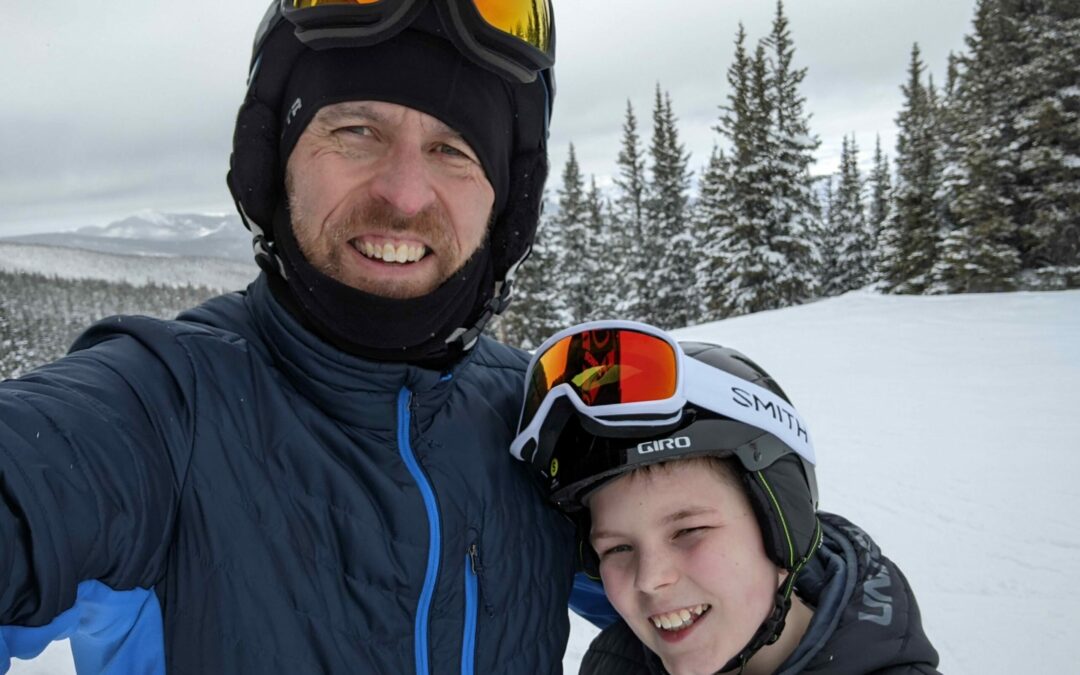A few weeks ago, I took my youngest son on a ski weekend to Colorado.
Skiing is one of my favorite things to do and being able to share it with my son is purely joyful. But that’s not the point of sharing this story.
My son is new to skiing. This was only his second time out, so he’s very much in learning mode.
On our first day, we started on a very simple, short hill where he felt safe and comfortable enough to practice. After making several successful trips down without a fall, his confidence grew. So, naturally, I convinced him we should try a longer run.
We jumped on a lift and made our way to the top of a much longer but still easy path down the mountain.
As we made our way, some parts of this run were more narrow and, thus, looked intimidating to him. He became uncomfortable and his confidence started to wane.
I reminded him that he was in control of how fast he wanted to go. But also that we had to keep going. It was our only way down.
He pushed through his discomfort and successfully made it to the bottom – confidence restored.
That night over dinner, I planted a seed with him that perhaps we should go all the way to the top of the mountain the next day. On the map, it certainly looked like there were plenty of easy runs from there to make our way down.
He was unsure but said he’d think about it.
The next morning, we headed back out for more skiing.
Again, he wanted to ease into things on the easy hill we started on the day before. After a couple of times down, he was ready for the same longer run we’d done the day before.
This time, he had no hesitations and was all confidence.
Once we reached the bottom, he okayed a trip to the top. While he was still a little nervous about what we’d find when we got up there, he did it.
I was proud of him.
Once we got to the top, we discovered some amazing runs he absolutely loved. We stayed at the top for the rest of the day.
Discomfort is the Path
What I realized during our time skiing was that my job (besides being a “fun dad”) was to help nudge him outside of his comfort zone.
Nothing was unsafe or beyond his capabilities. It was all just a stretch and an opportunity to try something that looked a little daunting.
Once he made the choice to get a little uncomfortable, awesomeness awaited.
Granted, the payoff to risk ratio in this example is really high with the benefits being immediate compared to most decisions we make in life.
But it’s a great example of how our willingness to get uncomfortable is the key to the things we really want (and maybe more).
This came to mind for me this week as I was preparing to teach a management class.
Most of what I was teaching that day were skills that require managers to try something new with their people.
In this particular case, we were talking about how to build trust. Trust building requires a level of vulnerability that many people aren’t comfortable with–particularly at work.
Discomfort.
I was asking them to ask their direct reports for feedback on how they can better demonstrate trust behaviors.
Discomfort.
They learned that the best way to earn trust is to give it first, often before you know if the person is trustworthy.
Discomfort.
Unfortunately, the bad news for these managers was that there was no way to avoid the discomfort. No shortcut is available.
This leaves them with two options:
- Move into the discomfort to build trust.
- Make no progress.
The payoff to having trusting relationships with your team is enormous. Maybe it’s not skiing off the peak of a mountain, but it’s pretty good.
There is no path to trust that doesn’t require a departure from our “comfort zone.”
The Upside of Discomfort
What I have discovered and what I’m hoping to instill in others (my son and the managers I train as well) is learning how to embrace the feeling of discomfort.
When you are uncomfortable, you are likely on the verge of learning, growing, or breaking through to something good.
If you can find the courage to step into that discomfort, then I have more good news for you. Your tolerance for discomfort increases over time.
It used to be hard for me to admit mistakes and show vulnerability. My fragile ego at the time just couldn’t handle the discomfort of what people might think.
But, as I was able to push through this roadblock, in small ways at first, I discovered something amazing.
Each time I got outside of my comfort zone and survived, the size of that zone increased. Soon, things that used to feel risky and uncomfortable didn’t anymore.
Our comfort zone is expandable.
My son won’t hesitate to jump on a ski lift to the top of a mountain in the future if I tell him it’s safe to do so.
The same will be true for you.
The key to growth and the path to breakthrough learning is our willingness to get uncomfortable.
What decision or action have you been delaying because you know it’s going to be uncomfortable?
***
If you are not subscribed to my email list and would like to receive great content like this delivered straight to your inbox each week, click here to subscribe.

